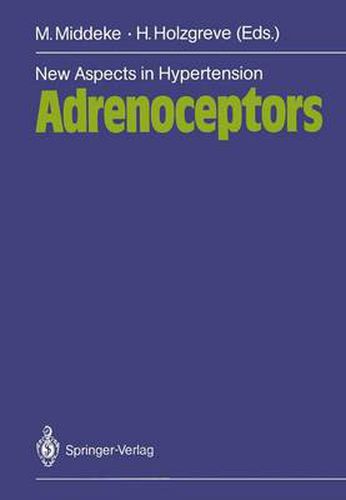Readings Newsletter
Become a Readings Member to make your shopping experience even easier.
Sign in or sign up for free!
You’re not far away from qualifying for FREE standard shipping within Australia
You’ve qualified for FREE standard shipping within Australia
The cart is loading…






This title is printed to order. This book may have been self-published. If so, we cannot guarantee the quality of the content. In the main most books will have gone through the editing process however some may not. We therefore suggest that you be aware of this before ordering this book. If in doubt check either the author or publisher’s details as we are unable to accept any returns unless they are faulty. Please contact us if you have any questions.
This book reports on the current state of knowledge about adreno ceptors and their involvement in the pathogenesis and treatment of high blood pressure. This is a relatively recent and extremely excit ing addition to the field of hypertension research. The development of new analytical procedures, such as radio ligand-binding methods, has made it possible to identify and quantify the adrenoceptors in different tissues and in circulating blood cells. As a consequence, much new and valuable information has been obtained. An under standing of the role of the fJ-adrenoceptor-adenylatecyclase-cAMP system in hypertension is one such product of this new approach. Both review articles and new experimental and clinical data are included in this volume. New aspects of the distribution, identifica tion and regulation, and the chronopharmacology of adrenoceptors, as well as beta blockade, will be highlighted. The clinical contributions concern the normal regulation of the fJ adrenoceptor-adenylatecyclase-cAMP system, and how it is altered in hypertensives as a possible mechanism in the pathogenesis and maintenance of essential hypertension. With this knowledge it is be coming easier to explain the molecular and cellular action behind the familiar role of the sympathico-adrenergic system in the devel opment of hypertension and the mechanism of beta blockade. The vast majority of the data available in this field is confined to periph eral mechanisms, owing to the limited possibilities for investigating the central nervous system under clinical conditions.
$9.00 standard shipping within Australia
FREE standard shipping within Australia for orders over $100.00
Express & International shipping calculated at checkout
This title is printed to order. This book may have been self-published. If so, we cannot guarantee the quality of the content. In the main most books will have gone through the editing process however some may not. We therefore suggest that you be aware of this before ordering this book. If in doubt check either the author or publisher’s details as we are unable to accept any returns unless they are faulty. Please contact us if you have any questions.
This book reports on the current state of knowledge about adreno ceptors and their involvement in the pathogenesis and treatment of high blood pressure. This is a relatively recent and extremely excit ing addition to the field of hypertension research. The development of new analytical procedures, such as radio ligand-binding methods, has made it possible to identify and quantify the adrenoceptors in different tissues and in circulating blood cells. As a consequence, much new and valuable information has been obtained. An under standing of the role of the fJ-adrenoceptor-adenylatecyclase-cAMP system in hypertension is one such product of this new approach. Both review articles and new experimental and clinical data are included in this volume. New aspects of the distribution, identifica tion and regulation, and the chronopharmacology of adrenoceptors, as well as beta blockade, will be highlighted. The clinical contributions concern the normal regulation of the fJ adrenoceptor-adenylatecyclase-cAMP system, and how it is altered in hypertensives as a possible mechanism in the pathogenesis and maintenance of essential hypertension. With this knowledge it is be coming easier to explain the molecular and cellular action behind the familiar role of the sympathico-adrenergic system in the devel opment of hypertension and the mechanism of beta blockade. The vast majority of the data available in this field is confined to periph eral mechanisms, owing to the limited possibilities for investigating the central nervous system under clinical conditions.